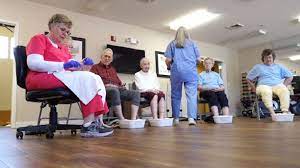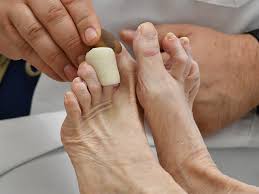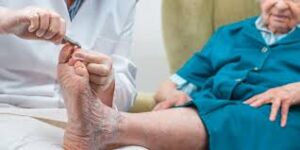Foot Care at Home for Elderly: As we age, our feet undergo various changes that can impact mobility, balance, and overall comfort. For elderly individuals, maintaining foot health is essential to avoid common issues like pain, infections, and loss of mobility. Ensuring proper foot care at home for elderly loved ones not only helps prevent foot-related problems but also supports their ability to stay active and independent.
In this guide, we will explore why foot care is important, discuss common foot health concerns among seniors, and provide practical steps to achieve effective foot care for seniors in the comfort of home.

Aging feet require special attention to prevent complications that may affect overall quality of life. As we grow older, foot skin becomes thinner, circulation decreases, and the body’s natural cushioning declines, which can make seniors more susceptible to discomfort and injury. Here are some key reasons why foot care for seniors is crucial:
With an effective routine for foot care at home for elderly loved ones, families can support seniors in leading more active and fulfilling lives.

Understanding the unique foot health concerns faced by the elderly is essential for creating an effective care plan. Common issues include:
Addressing these concerns with foot care for seniors can help mitigate discomfort and promote better overall foot health.
Creating a daily and weekly foot care routine at home can prevent many foot-related health issues in seniors. Here are some essential steps to include in an at-home foot care regimen:
Encourage seniors to check their feet daily for signs of cuts, redness, swelling, or changes in skin texture. A daily inspection can help catch small issues early, preventing them from becoming bigger problems. If reaching or bending is difficult, a handheld mirror can be useful for viewing the bottoms of the feet.
Maintaining clean, moisturized feet is key to preventing dryness and cracking. Seniors should wash their feet daily with mild soap and warm water, then pat them dry thoroughly. Apply a gentle moisturizer to keep the skin hydrated, avoiding the area between the toes, as too much moisture here can encourage fungal growth.
Toenail maintenance is an essential part of foot care at home for elderly loved ones. Toenails should be trimmed straight across to prevent ingrown nails, and the edges can be smoothed with an emery board. If trimming toenails is difficult, it may be wise to seek professional help from a podiatrist.
Supportive and comfortable footwear plays a significant role in reducing foot pain and maintaining balance. Shoes with non-slip soles, a wide toe box, and adequate arch support are ideal for seniors. Avoid high heels or shoes with narrow toe boxes, as they can cause blisters, calluses, and balance issues.
Foot and ankle exercises improve blood flow, maintain muscle tone, and enhance mobility. Encourage seniors to try simple exercises like ankle rotations, toe curls, and calf stretches to keep feet flexible and strong. Even light walking, if safe, can be beneficial for circulation.

Aging skin needs special care, and using a gentle, fragrance-free moisturizer can help seniors manage dry, cracked skin. Look for products with ingredients like shea butter, aloe vera, or glycerin, which provide deep hydration without irritation. Avoid harsh scrubs or exfoliants, as they may be too abrasive for delicate skin.
When soaking feet, encourage seniors to use warm water rather than hot, as hot water can dry out the skin and cause irritation. A simple foot soak for 10–15 minutes can soften skin and help ease any soreness or swelling. Adding a few drops of essential oils like lavender or chamomile can make this routine more relaxing, but it’s always best to check for skin sensitivities first.
Fungal infections like athlete’s foot and toenail fungus are common among seniors. To reduce the risk, encourage seniors to wear clean socks daily, avoid walking barefoot in public areas, and apply antifungal powder if necessary. It’s also essential to keep the area between the toes dry and avoid sharing nail clippers or footwear.
In certain cases, professional assistance from a podiatrist is essential for foot care for seniors. Seniors with diabetes, circulation issues, or severe pain should have regular foot evaluations by a healthcare provider. Podiatrists can help treat conditions like bunions, nail infections, and chronic foot pain, ensuring seniors receive the specialized care they need.
Family members and caregivers can play a vital role in ensuring seniors receive effective foot care at home for elderly loved ones. By setting up a clean, comfortable space for foot care, caregivers can make the process easier and more enjoyable. Additionally, caregivers can help seniors with tasks that may be physically challenging, like reaching down to inspect or moisturize feet.
A few simple tools can help make foot care easier and safer for seniors:

Although many aspects of foot care at home for elderly individuals can be managed independently, certain signs may indicate the need for medical attention. Seniors should seek help from a healthcare provider if they notice:
Timely intervention can prevent complications and provide seniors with the care they need to maintain foot health and comfort.
Taking the time to implement foot care at home for elderly loved ones can have a profound impact on their quality of life. Proper foot care for seniors not only prevents common issues but also supports mobility, reduces fall risk, and contributes to an overall sense of well-being. By following these at-home care tips, family members and caregivers can help seniors maintain healthy feet and continue enjoying their independence and comfort.
By addressing foot care needs with a supportive, proactive approach, families can empower elderly loved ones to age confidently, one step at a time.